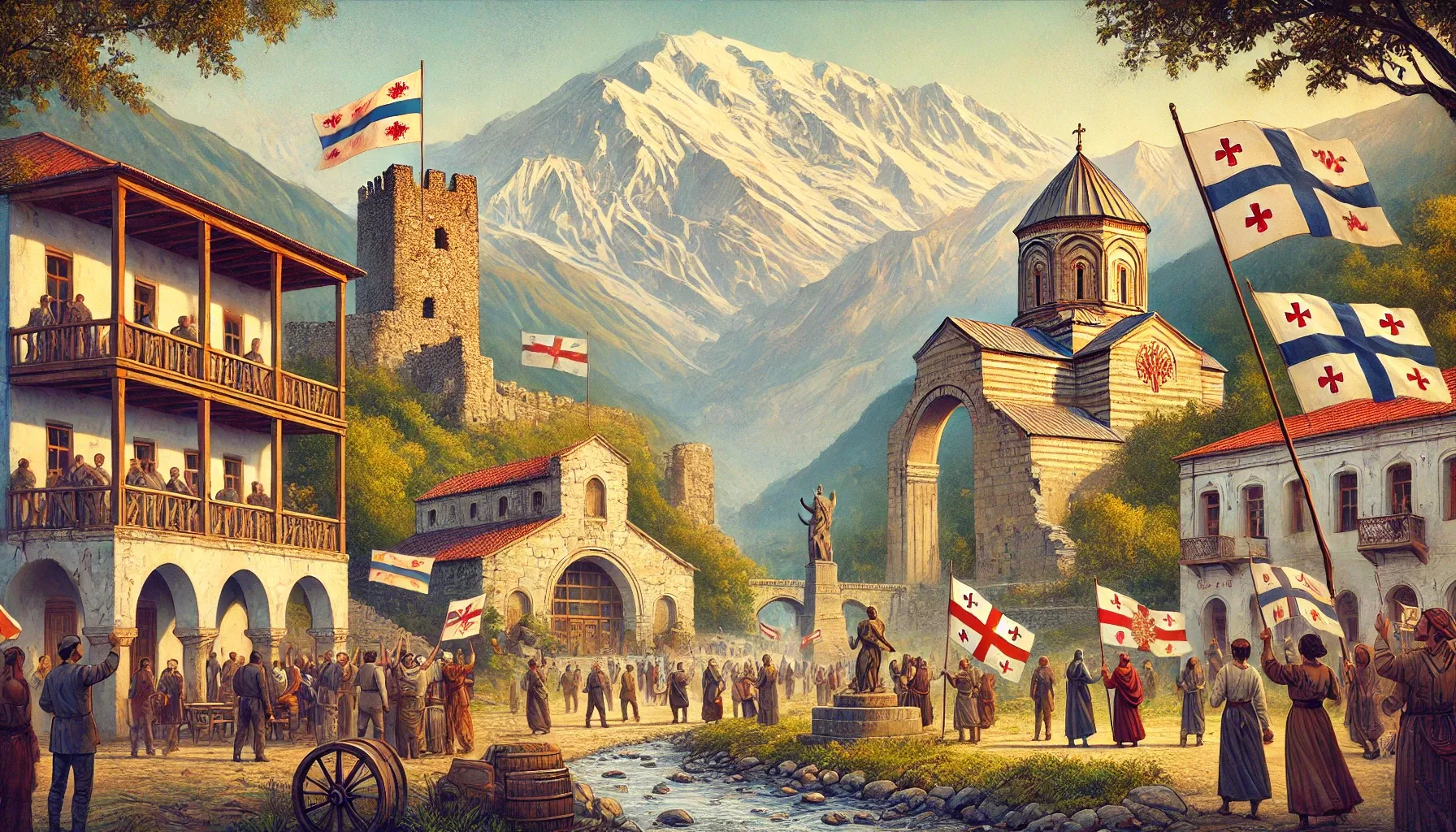What is known about the geography and population of Abkhazia?

- Geography and culture of Abkhazia: what do you need to know about the republic?
- How did the annexation of Abkhazia change its history and present?
Geographical characteristics of the Republic of Abkhazia
The geographical characteristics and demographics of the Republic of Abkhazia, recognized as an independent authority, are also referred to in accordance with Georgian legislation as the Abkhaz Autonomous Republic. This country is located in the northwestern part of the South Caucasus and is bordered by the Black Sea to the northeast. To the north and northwest, Abkhazia shares its borders with Russia, while the eastern and southeastern regions neighbor Georgia. The total area of the Republic of Abkhazia is approximately 8,600 square kilometers.
Climate and the main settlement
The climatic conditions of the region are determined by the high mountain ranges and its proximity to the sea. The coastline features a humid subtropical climate. Winter temperatures in January range from +2 to +4 °C, while in the summer months, in August, they reach +22 to +24 °C. The capital of this region is the city of Sukhumi, and the largest settlements include:
- Gagra
- Pitsunda
- Gudauta
Administrative division and demographics
The governance structure of the republic is divided into seven districts, which symbolize the seven stars on its national flag:
- Gagra
- Gudauta
- Sukhumi
- Gulrypshsky
- Ochamchira
- Tkvarcheli
- Gal
The population of the country is over 242,000 people. The composition of the population includes about44%Abkhazians,21%Georgian,21%Armenian11%Russians and about1%Greeks. The remaining ones4%representatives of other nationalities make up.
Religious structure
According to a survey conducted in 2003, the main religious group consists of Christians, who make up60%Muslims make up a portion of the total population.16%those who adhere to traditional Abkhaz beliefs –3%There are pagans5%and atheists -8%, and2%– followers of other religions. More.6%of respondents found it difficult to answer.
Language situation
The official language in Abkhazia is Abkhaz, however, a significant portion of the population speaks Russian and Georgian, and in several institutions, Russian is used as the working language.
Historical aspects
Speaking about the history of Abkhazia, it is worth noting that people have lived in the region since the 4th millennium BC, engaging in agriculture, animal husbandry, weaving, and pottery, as well as metalworking – copper and bronze. The local population actively participated in trade.
In the second half of the 1st millennium BC, Greeks began to settle in the territory of Abkhazia, establishing port colonies such as Dioscurias, located at the site of modern Sukhum, Gienos — at the site of Ochamchira, and Pitiunt in Pitsunda. By the beginning of our era, the Romans also strengthened their positions on the Black Sea coast by building fortresses.
From the 4th to the 6th century, Abkhazia was part of the Byzantine Empire, and it was during this period that Christianity spread across the territory of the republic, significantly influencing the cultural development of the region. By the end of the 16th century, Abkhazia and all of Western Georgia had become increasingly dependent on the Ottoman Empire. The Ottoman Empire built numerous fortifications along the Black Sea coast, including Sukhum-Kale (modern-day Sukhum), Poti, and Anapa.
This led to a significant number of Abkhazians embracing Islam, which also changed the cultural and religious traditions of the region.
The historical context of the annexation of Abkhazia
As a result of the appeal by Safarbay Georgy, who was the ruler of Abkhazia at that time, to the Russian authorities requesting protection for his territory, a manifesto by Emperor Alexander I was signed on February 17, 1810 (February 29 according to the old style). This document confirmed the incorporation of the Abkhaz principality into the Russian Empire.
The annexation of Abkhazia marked a new chapter in the region's history, opening new horizons for its economy and culture, which led to significant changes in local life. However, following the conclusion of the Russo-Turkish War of 1877-1878, there was discontent among the Abkhaz population regarding the policies of the Russian Empire, prompting a significant number of people to leave their historical lands.
9 October 2024
29 September
9 October 2024
The period after the February Revolution
After the February Revolution of 1917, control over Abkhazia passed to the Mensheviks. From November 1917 this region was included in the Transcaucasian Commissariat. On March 28, 1921 Abkhazia declared its independence as a Soviet Socialist Republic.
Very soon, on December 16, 1921, in accordance with a special union agreement, Abkhazia became part of the Georgian Socialist Soviet Republic.
Modern statements of independence
On August 26, 2008, Russian President Dmitry Medvedev signed a decree recognizing the independence of Abkhazia. However, it should be noted that the majority of countries in the world did not support this decision.
As an independent state, Abkhazia has been recognized by only a few countries, such as:
- Nicaragua
- South Ossetia
- Other countries in search of international recognition
A number of countries, includingBelarus,VenezuelaandSomaliaThey also expressed a desire to recognize the independence of Abkhazia.
Political structure of Abkhazia
With regard to the structure of power in Abkhazia, it is a de facto presidential republic. The president plays a significant role as head of state, is the guarantor of the Constitution and heads the executive branch, and also serves as commander-in-chief of the republic's armed forces.
The position of the president includes leading the cabinet of ministers. The term of office of the head of state isfive yearsAlthough the same person can hold this position for no more thantwo consecutiveterms.
Legislative power in the Republic is exercised by the People's Assembly consisting of 35 deputies. Parliamentary elections are held on the principles of universal, equal and direct suffrage by secret ballot. The term of office of the People's Assembly is alsofive years.
The economic base of Abkhazia
The modern economy of Abkhazia is largely based on trade and tourism activities. According to data from the Ministry of Economy of Abkhazia, the trade sector accounts for about60%of the gross domestic product, while the tourism industry contributes to thethirdin total tax revenues.
Every year, hundreds of thousands of tourists visit the country, mainly from Russia. The official currency of Abkhazia isRussian rubleThis also emphasizes the region's economic ties with the Russian Federation.

Conclusion
As a result of studying the geography, population, and history of the Republic of Abkhazia, I have come to realize the complexity of this region, which continues to attract the attention of both tourists and historians. Despite its political challenges and ambiguous status, Abkhazia represents a unique blend of cultures, historical ideas, and picturesque landscapes that create an atmosphere capable of impressing even the most discerning travelers.
As a home to many ethnic groups, this republic is enriched by a diversity of traditions and beliefs, which is evidenced by the multilingualism and multinational character of its population.
It cannot be ignored that the history of Abkhazia is full of turmoil and conflicts that have left a significant mark on its fate. From ancient Greek colonies to modern recognition of independence, each stage of its development has paved the way for the challenges the republic faces today. The ways in which Abkhazia has adapted to changes in the political and economic landscape of the region highlight its resilience and desire to find peaceful means of coexistence in a multinational context.
Economy and potential
An economy based on tourism and trade shows potential for growth and prosperity. The desire to restore representations and strengthen international ties is an important step that could lead to the development of a "new chapter" for Abkhazia.
- Tourism: the foundation of economics.
- Trade: accounts for a significant share of GDP.
- International relationsare important for further development.
Although its recognition on the international stage remains a complex issue, the internal resources and the wealth of culture, nature, and the human spirit contribute to hopes for a bright future.
Thus, the Republic of Abkhazia is not just a geographical unit, but a living testament to the struggle for identity and distinctiveness. I hope that my research has drawn your attention to this interesting region and that you will become interested in its cultural and historical heritage. Perhaps with each step towards understanding the uniqueness of Abkhazia, we can see how diversity of opinions and cultures can become the basis for peaceful coexistence and mutual understanding.
Comment
Popular Posts
9 October 2024
1485
29 September
350
9 October 2024
9935
Popular Offers

Subscribe to the newsletter from Hatamatata.com!
Subscribe to the newsletter from Hatamatata.com!
I agree to the processing of personal data and confidentiality rules of Hatamatata














